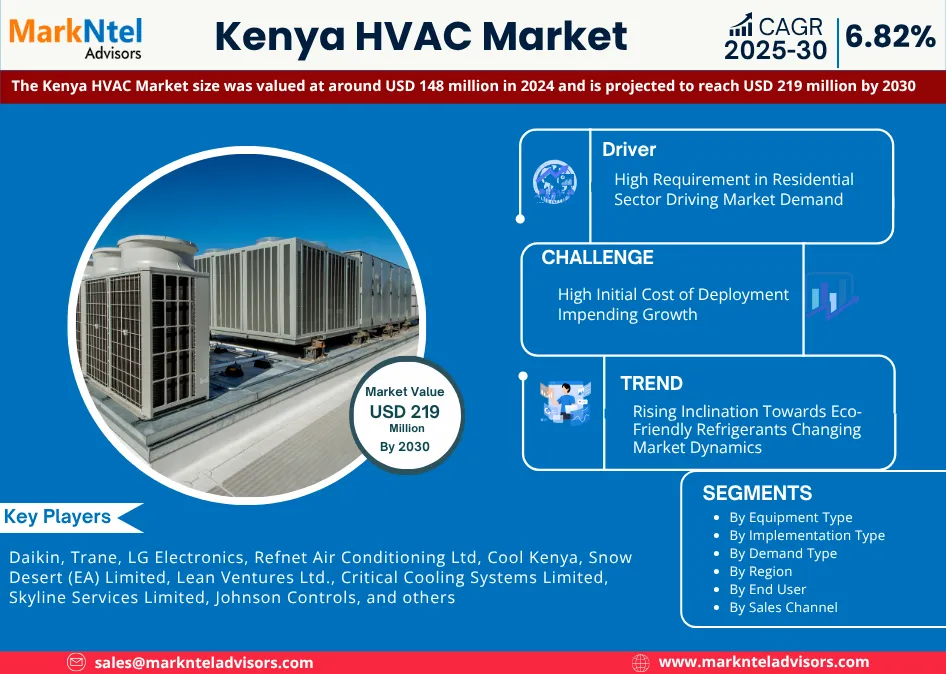Press Release Description
Kenya HVAC Market to Reach USD219 Million Mark by 2030
The Kenya HVAC Market size was valued at around USD 148 million in 2024 and is projected to reach USD 219 million by 2030. The market is also estimated to grow at a CAGR of around 6.82% during the forecast period, i.e., 2025-30, cites MarkNtel Advisors in the recent research report. Various new projects are being developed in major cities of Kenya to support the growing urban population. These projects require cooling solutions due to the hot climate of the region. This creates a high demand for HVAC systems. This is also followed by an increase in residential, commercial, and industrial developments that require efficient climate control systems. Also, the intense heat has now made these systems a necessity, which were earlier just a luxury. Thus, the demand for comfort-enhancing technologies like air conditioning systems is increasing rapidly.
Moreover, the growing government support by the introduction of numerous favorable polices like the Energy Transition and Investment Plan 2023-2050 (ETIP) and the National Cooling Action Plan (NCAP) to promote energy-efficient and environmentally sustainable cooling technologies has further boosted the market growth.
Additionally, several trends are shaping the market dynamics. The introduction of smart and inverter-based HVAC systems that are boosted with IoT and AI technologies helps in enabling remote monitoring and enhanced energy efficiency. Also, the rising focus on the use of eco-friendly refrigerants by various companies in the country to reduce global warming is becoming a major part of the market shift towards sustainability. This will further create developments in technology that will provide growth opportunities during the forecast period.
The market provides various lucrative opportunities for market players. The integration of renewable energy with HVAC systems by powering them through solar energy presents a promising avenue for market expansion. Also, modular & customizable solutions having ease of maintenance, reduced installation time, and scalability for future requirements are gaining popularity in the market that can cater to the specific needs & spaces of the consumers.
However, several factors are impeding the market growth. The initial high cost of the development of modern and energy-efficient HVAC systems remains a barrier for various businesses. Inconsistent electricity supply and relatively high energy costs further limit full-scale adoption. Also, the regulatory compliance and enforcement of HVAC standards remain weak, which can delay the availability of critical components, further states the research report, “Kenya HVAC Market Analysis, 2025.”

Kenya HVAC Market Segmentation Analysis
Commercial Sector Holds the Largest Market Share
Based on the end user, the market is further bifurcated into Commercial, Residential, Industrial, Healthcare, Airports, Logistics, and Others. The commercial sector holds the majority share of around 47%. This is because of its unique operational requirements in high-occupancy environments like malls & hotels. Also, the need for climate control in mixed commercial spaces necessitates reliable and scalable HVAC infrastructure. The increasing investment by FDI in setting up offices according to global workplace standards essentially requires these systems. Moreover, the growing hospitality industry, driven by tourism & business, further enhances the market demand. Apart from this, the commercial sector has many projects as compared to other sectors, creating a major requirement for these systems. The sector will continue to dominate the market during the forecast period as well.
Construction Segment Creating Major Market Demand
Based on implementation type, the construction segment leads the Kenya HVAC Market. It holds approx. 70% share of the total market value. The expansion of infrastructure requires the installation of these systems. The growth of this segment is due to the increased construction in various industries of Kenya requiring modern cooling solutions. Also, these activities have been accelerated by the government’s investment in affordable housing and urban planning. These projects typically integrate energy-efficient and sustainable HVAC systems from the starting itself, which aligns with national goals. Moreover, the new installations offer better flexibility and lower long-term operational costs, as compared to retrofitting. This has created more opportunities for the segment’s growth and thus determines its dominance in the market.
Competitive Landscape
With strategic initiatives such as mergers, collaborations, and acquisitions, the leading market companies, including Daikin, Trane, LG Electronics, Refnet Air Conditioning Ltd, Cool Kenya, Snow Desert (EA) Limited, Lean Ventures Ltd., Critical Cooling Systems Limited, Skyline Services Limited, Johnson Controls, and others are looking forward for strengthening their market positions.
Key Questions Answered in the Research Report
- What are the industry’s overall statistics or estimates (Overview, Size- By Value, Forecast Numbers, Segmentation, Shares)?
- What are the trends influencing the current scenario of the market?
- What key factors would propel and impede the industry across the country?
- How has the industry been evolving in terms of geography & product adoption?
- How has the competition been shaping up across various regions in the country?
- How have buying behavior, customer inclination, and expectations from product manufacturers been evolving during 2020-30?
- Who are the key competitors, and what strategic partnerships or ventures are they coming up with to stay afloat during the projected time frame?
We offer flexible licensing options to cater to varying organizational needs. Choose the pricing pack that best suits your requirements:
Buy NowNeed Assistance?
WRITE AN EMAIL
sales@marknteladvisors.comCustomization Offered
100% Safe & Secure
Strongest encryption on the website to make your purchase safe and secure
